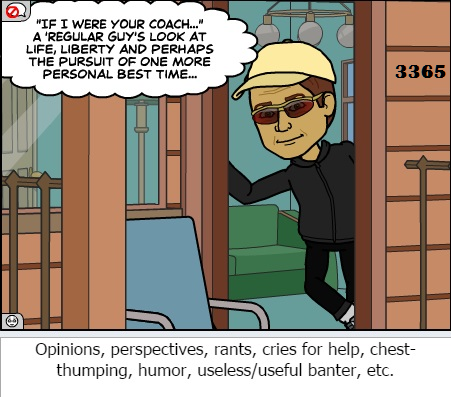Angela and I both ran a 5K the previous morning so the pace was guaranteed to be more sedate...by my standards, which means an abundance of teachable moments. I wasted no time in discussing a few take-aways from our respective race experiences, the first in almost six months for me.
First topic was a recapitulation of the "chin theory" of run training. If training is a bad idea for an athlete who is suffering from illness, specifically chest-based congestion, then racing might be more so. If the event is an "A" race, with some sort of reputation or livelihood at stake, I guess there's a good reason to continue. That means most likely 99 percent of the running world would be better served eating the race entry fee...unless there's a trip involved, in which case begging for refunds and deferrals if possible seems the order of the day. I'd shake off lesser priority events, too. If you have to participate, lower the expectations and keep the performance in perspective.
Speaking of keeping performances in perspective, I mentioned my performance goal for either the previous day's race or the target race which was coming up the next week. A couple of years back, a healthy and race-sharpened me could click off a 6:00/mile guy over the course of 5,000 meters without thinking twice. Dinged-up achilles' tendons and a solid year of almost no running left me at eight-minute pace (followed by much wind-sucking) six months ago. Speed workouts on the treadmill consisted of a handful of one-to-two-minute repeats at 7:00/mile pace; my goal was to stay as close to seven-minute pace as possible. I was painfully close; emphasis on painful, managing a 7:06/mile for 5K. It wasn't the legs which couldn't handle it, nor the cardiovascular. Definitely the respiratory system which was not up to par.
The great Czech distance runner Emil Zatopek explained the blend of speed and endurance at the heart of his training regimen. He was known for workouts which consisted of short distance (often 400 meters or shorter) repeats at his desired race pace or faster. Naturally, the quick pace repeats developed speed (I had the neuromuscular side of the running equation correct). What I forgot to remember, however, was that Zatopek developed endurance by running countless miles worth of those repeats at desired race pace or faster.
Tim, our visitor, had caught up with us mid-topic. I figured it was time for me to catch my breath (and sneakily ramp up the pace) with the classic open-end question, 'so what's your race goal?'
He began to discuss his training, as well as that of the group he runs with in the Northeast, and discussed the challenges of winter training, like running 20-milers on an indoor track. I'm not certain which is more tedious, treadmill runs or indoor track runs. He then asked my opinion of a particular workout, often performed as part of marathon training to gauge a target performance. I won't mention the name or the running author who first described it some years ago, as I consider him a good friend. Oh, heck, I'm not slamming Bart Yasso's 10-by-800 meters with 400-meter recoveries, each run at an "hours-to-minutes pace." For those unfamiliar with Yasso 800s, a person training to run a 3:30 marathon would run their 800-meter repeats in 3 minutes, 30 seconds.
I told Tim I did not think a single particular workout could be an accurate predictor of a performance, especially not something as long as a marathon. A lot of things can potentially happen over the course of 26.21876 miles; some can be trained for, others cannot. If, for example, your goal is to run a 3:30 marathon it is absolutely necessary to be able average a 7:55 mile for 20 kilometers. For what it's worth, that's approximately the range that Dr. Jack Daniels' VDOT tables recommend as a marathon training pace for a person whose predicted marathon performance is 3:30.
The problem comes when our training efforts are not specific for the task at hand. I had reminded my neuromuscular system what it was like to go seven-minute-per mile pace with the number of repeats I had done over the past month or two. However, I hadn't provided enough sustained efforts, lasting up to 20 minutes, to develop the cardiovascular and respiratory systems. A runner focusing on the 5,000 meters, averaging 30 miles a week, would benefit from at least two miles of training which exceeds aerobic paces...for that 3:30 marathon dude who decides to focus for a time on the 5K, that's probably no more than fifteen minutes out of the week.
Marathon training is even more aerobic, so the hard stuff might be only five minutes worth of the entire training week, but the overwhelming majority of work should be closer to the high end of the individual's aerobic capacity. While the training is aerobic, it does not mean that the training miles are easy.
To be "specific," slow training leads to slow racing.

